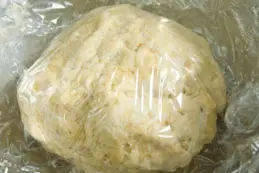Making empanada dough correctly is the hardest part about the whole process of putting together the perfect empanada. I spent some long hours trying to get the dough just right; looking at every recipe on the internet I could find, and then some. I tried recipes with yeast, baking powder, corn flour, butter, shortening, spices, eggs, etc. None of them turned out the way I wanted. To save you time, I have put together a list of empanada mistakes so you can read them without actually experiencing the same problems I had.
Then, it just so happened that I spent some time with an Argentinean chef at one of the beaches here in Costa Rica that we know. I don’t know why I didn’t call him first without bothering with internet recipes. Once I talked to him about my recipe woes, my whole empanada world changed. If anyone knows about preparing those little pockets of heaven, it’s an Argentinian.
He explained a few things to me. First, depending on whether you’re going to bake or fry them, you need to prepare them differently. Fried dough should use solid shortening while baked dough uses butter. If you use butter in a fried dough recipe, you’ll most likely end up with it opening in the hot oil and making a crumbly mess. Shortening works okay in a baked dough, but it changes the consistency of the dough once it’s cooked so it’s best to stick to the rule of cold butter for baked and shortening for the fried variety.
The next key to the baked version of empanada dough is to keep all ingredients ice cold. So, use all purpose flour that has been kept in the freezer, butter that is fresh out of the fridge and ice water to mix. After it’s all mixed it’s crucial to keep the dough in the fridge for at least three hours before using it. This insures that the dough is the right texture and doesn’t become too elastic to work with.
Once you master the empanada dough recipe, you’ll want to explore the filling options for your taste. We have chicken empanada filling recipes, beef empanada filling recipes, pork empanada filling recipes, fish and seafood empanada filling recipes and vegetarian empanada filling recipes.
Here are the two no-fail recipes I use to get the restaurant-quality empanadas you can find at Argentinian steakhouses.
Contents
Baked Empanada Dough Recipe
Ingredients
- 3 Cups of Flour
- 1 Tsp Salt
- 1-3 Tbsp dried herbs and/or (non-salted) spices as desired
- 1/2 Cup cold butter
- 3/4 Cup ice water
Directions
- In a medium-sized bowl mix flour, salt and 1-3 tablespoons of herbs/spices to taste.
- Cut the butter into small squares and place in bowl with flour mixture. Using a pastry cutter, cut in butter until you have a cornmeal texture. If needed break up large pieces of butter with your hands, but don’t bring up the overall temperature of the mix.
- The mixture should be slightly lumpy and look like a coarse cornmeal with the butter well incorporated.
- Slowly incorporate 3/4 cup of ice water, adding a little at at time until a dough ball forms. The dough should not be sticky and should be kneaded about 10 times. If needed, add more flour or water to reach the appropriate consistency.
- Cover with plastic wrap and refrigerate overnight (or at least 3 hours).
- When you assemble and are ready to bake, preheat oven to 350F and bake for 10-15 minutes or until golden, but not brown on the underside or the edges.
Fried Empanada Dough Recipe
Ingredients
- 3 Cups of Flour
- 1 Tbsp Salt
- 1-3 Tbsp dried herbs and/or (non-salted) spices as desired
- 1/2 Cup room temperature solid shortening
- 3/4 Cup luke warm water
Directions
- In a medium-sized bowl mix flour, salt and 1-3 tablespoons of herbs/spices to taste.
- Cut the shortening into small squares and place in bowl with flour mixture. Using a pastry cutter, cut in shortening until you have a cornmeal texture. If needed, break up large pieces of shortening with your hands.
- The mixture should be slightly lumpy and look like a coarse cornmeal with the shortening well incorporated.
- Slowly incorporate 3/4 cup of water, adding a little at at time until a dough ball forms. The dough should not be sticky and should be kneaded about 10 times. If needed, add more flour or water to reach the appropriate consistency.
- Use immediately or cover and refrigerate. Bring to room temperature before using.










[…] found some nice tips on making empanadas here. Let me know if there are any tips we should be aware […]
[…] tried a new recipe for supper tonight. I got this recipe and the beef filling from this website. These turned out very good and we will make them again. I ended up getting 11 empanadas from […]
Thank you! !Gracias! Merci! I’ve struggled with empanadas recipes without knowing why I was supposed to be doing those things. Most times the recipes were quite casual in their approach & made the steps seem almost unimportant. I will confess that sometimes I cut corners when time made them inconvenient and made mistakes trying to be creative. Your explanations will give me the framework that will allow me to both do it correctly and be adventurous. Thanks again.
You’re very welcome. Please check out my other post where I go through mistakes specifically: http://cheapfoodhere.com/groceries/help-in-the-kitchen/common-empanada-mistakes
I’ve done the dough for baking and the filling. Have not assembled yet, but saw the video and should be ok with that but I can’t find anywhere oven temperature or time to bake these. Should I use some nonstick spray? Also, I am a little worried that 1tbsp of salt is too much. Is that right or is it tsp? Thanks.
These turned out great! I did a 350F oven and they took 30min. Longer than I thought they would but they were delicious. Thanks for the information.
Thanks for the update. Even though I have made the dough dozens of times, you had me worried about the 1 TBSP. Was it 1 tsp instead? Glad they worked out for you.
I prepared the dough and the veg filling. I prepared the empanadas but then i was struggling to find the oven temperature. I didn’t find it in the dough and the fillings recipe pages. At what temperature should i preheat and cook the empanadas? Right now they are cooking at 400F. Lets see how they turn out. Thanks very much for the recipe. I also gave it an Indian twist 🙂
I love the Indian twist! Curry empanadas are the best. So, I always bake them at 350F but don’t think 400F would be bad, just watch them to make sure they don’t get burnt on the bottoms or around the edges.
Thanks so much, I have been searching and searching for a good empanada recipe. I made these “hot pockets” style, with ham and cheese inside, easy & quick. The only thing is this didnt cook for me at ten minutes, it was more like 25 minutes. Maybe I rolled the dough too think IDK. But thank you, this is going in my file to make over and over.
Sorry I am still a little confused on the comments about the amount of Salt. So is it 1 tablespoon or 1 TeaSpoon. I used 1 Tablespoon and when tasting the dough I could feel the grains of salt.
Hi Mark,
I’m sorry for the confusion, yes, it should be 1 teaspoon of salt. I have corrected the recipe. Thanks so much for writing in!
How many 6 inch empanada rounds would this recipe make?
Hi jessica,
This recipe should make 8-10 empanadas at 6″.
Hope this helps.
In baking bread I use proportions based on the weight of ingredients. How much does the 3 cups of flour in the recipe weigh?
Hi thanks for the question. A cup of flour properly measured should weigh 120 grams, so three cups would weigh 360 grams for this recipe.
Hi, I’ve just started to experiment with making empanadas for the first time. I’m glad I found your site. Lots of great tips and recipes! I have one question. Is there a reason you don’t add distilled vinegar to your baked dough recipe. I’ve only tried one other recipe using the vinegar addition and it turned out well. Also, I noticed in your fried dough recipe you have listed 1 tablespoon of salt. I believe it should read 1 teaspoon like the baked dough recipe. Can you confirm please? Thank you for an exceptionally well done website.
Hi Susan. Empanadas are amazing and yes, it should be 1 tsp! I corrected it on the baked dough recipe but forgot about the fried dough. Thank you for calling that out, i have updated it!
Happy cooking!
Hi there!
What do you think of using Vinegar in the dough?
I’ve read that it gives it a flakier result?
Thanks for all the tips!
Veronica
Hi Veronica, I’ve heard the same thing but honestly have never tried. If you do, let me know what it does! Good luck.
Hello, I was looking for fried empanada dough recipes and came across your site. I was wondering if you could make the dough, cut out the circles and freeze it with wax paper in between? Can you do it for both baking and frying empanadas?
Thank you!
Hi Aubrey. I haven’t done this before with these recipes, but I’ve seen frozen empanada circles in the freezer section of Latin grocery stores, so I bet it would work. Good luck!
Is there a substitute for shortening when making the dough for frying?
I would try coconut oil if you have that. You want a high heat solid fat to get the consistency you want. Good luck!
Do you know how to scale this to make 100 times the amount?
Hi there. Unfortunately, no. I’ve never needed that much dough. Sounds like you are feeding quite a crowd 🙂
Thank you so much for these recipes and wonderful tips. I am excited to try this out soon. I plan to scale this up for a large party and will probably need to put this all together in several different steps.
My questions are:
How long will the dough stay good before baking?
Would it work if I made the dough on a Thursday night and refrigerated overnight, assembled the empanadas with the filling on a Friday night and then refrigerated and baked it on a Saturday night?
Also wondering if I can cut the dough into rounds and store in the freezer for later assembly.
Hi Brandon,
Great questions, and I think the answer is ‘yes’ to all of them. I would keep the dough for up to 4 days in an airtight container in the fridge or freeze it. I’ve had success assembling the day before and frying/baking the next day, just make sure you close them completely or the filling will leak out.
Good luck!
– Ashley
Can I put beaten egg on the dough mixture? Some site suggesting that you can put some seasonings like cumin and garlic powder. Some also use milk instead of cold water? How does these things will affect the texture/ appearance/taste of the empanada dough. I just want a tastier dough. Thank you and hoping you will reply to my question
Hi Dyan, your best bet is to experiment on your own by making small tweaks and seeing how you like it. I wouldn’t try anything too dramatic at first, since it could really change the flavor and texture of the dough. Seasonings should be fine, I’m excited for you to try to make this recipe your own!